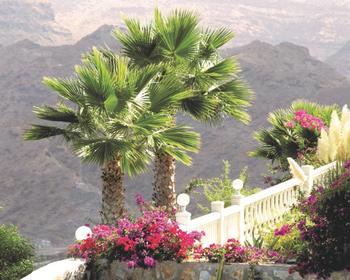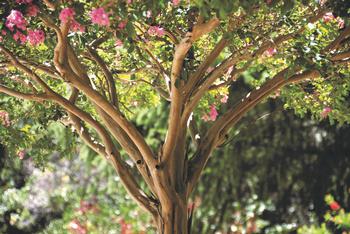
Several different varieties of palm trees do well in dry conditions. Photo: Inger Anne Hulbækdal, Dreamstime.com
We all know that Marin’s fabulous oak trees can withstand drought conditions, but even these beauties have been stressed with the seemingly more persistent dry weather. Marin Master Gardeners, in conjunction with the University of California, even recommended a few years ago that with oaks exhibiting drought stress, careful summertime watering with an arborist’s approval is appropriate. Our redwoods generally do OK during drought but need to be in their natural habitat, relying on cool, foggy conditions to thrive. If not, they will need some irrigation since they are so shallow-rooted. Most gardeners agree that tree survival during drought should be a top priority since trees add so much value to our property, environment, and wellbeing and are more difficult and costly to replace than shrubs and perennials.
If you have lost a tree and want to replace it or are planning a new garden, which trees are best to consider with dry conditions? The space where the tree is intended to go, its eventual size, and what you would like from it are most important to your choice. And just about any tree will need watering while it is getting established (a couple of years, at least), so good to plant in the fall when the chance of upcoming rain increases. For example, your home may be on a hillside, and you’re looking for a fast-growing tree that is deer resistant to help with erosion control. On the other hand, you may want a beautiful shade tree near your garden patio. Whatever your needs, consider the tree’s water needs, going forward into what looks like a changing climate that may bring less rain, stronger winds, and warmer temperatures.
Some of the most drought/deer-resistant and soil-securing trees (fir, pines, spruce, cypress, etc.) are going out of favor due to the belief that they increase fire danger in WUI areas (Wildland Urban Interface). While this may be true in some cases, many drought-resistant trees (both deciduous and evergreen, native or not) can safely be planted away from the house. For wildfire safety, placement and scrupulous maintenance are most important. Check out
Firesafemarin.org for tips on making trees designated as “fire-hazardous” safer. Go to
Calscape.org for a comprehensive list of native trees, their natural environs, and needs. Grab your favorite gardening guide and spend some relaxing time familiarizing yourself with hardy, Waterwise non-natives.

Among other things, waterwise crepe myrtles are prized for their attractive bark. Photo: Randy Miramontez, Dreamstime.com
There are many trees that can do with little water, are attractive, and can be planted in your garden closer to the house. These days, a popular street tree is the Chinese pistache (Pistacia Chinensis). Deep but non-invasive roots, moderate growth to 30 to 60 feet, deciduous with beautiful fall foliage and berries, it requires little water once established. Many varieties of crepe myrtle (Lythraceae) require infrequent (although deep) watering, making them a good choice for the water-wise garden. Nice-looking wood, showy summer flowers, fall foliage, hardiness, and low maintenance make these trees a popular choice. Another good option--Olive trees (Oleaceae). These trees come in both fruiting and fruitless varieties, and are loved for their gray-green foliage, the gnarled form that they take on with age, and their hardiness, not to mention the olives if you’d like to take on the challenge of making your own olive oil! Several varieties prefer dry climates if you are partial to palm trees, but be prepared to occasionally de-thatch and/or shave to make them more fire safe.
 Several different varieties of palm trees do well in dry conditions. Photo: Inger Anne Hulbækdal, Dreamstime.com
Several different varieties of palm trees do well in dry conditions. Photo: Inger Anne Hulbækdal, Dreamstime.com Among other things, waterwise crepe myrtles are prized for their attractive bark. Photo: Randy Miramontez, Dreamstime.com
Among other things, waterwise crepe myrtles are prized for their attractive bark. Photo: Randy Miramontez, Dreamstime.com

